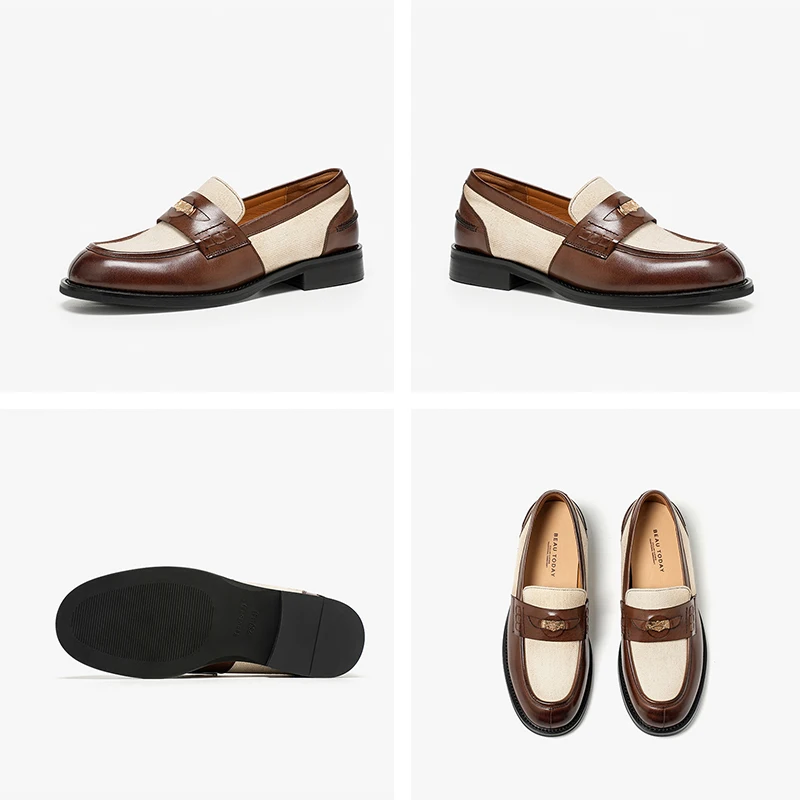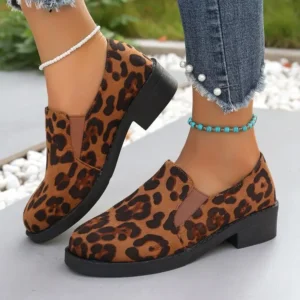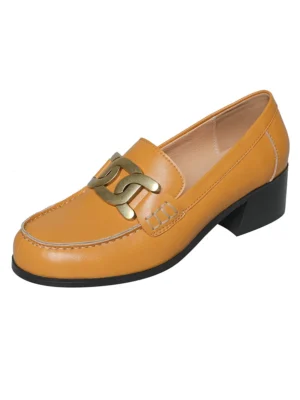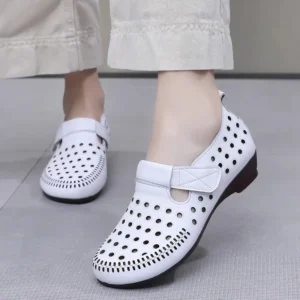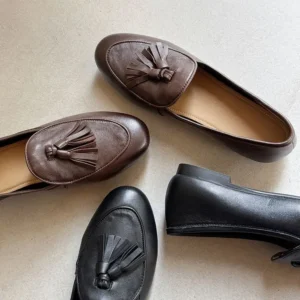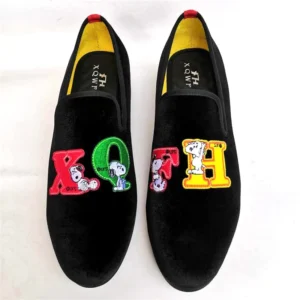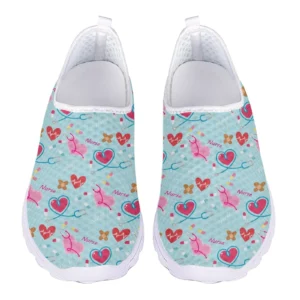Introduction: The Professional Appeal of Leather Loafers
Leather loafers have earned their place as one of the most versatile and sophisticated footwear options in professional wardrobes. These slip-on shoes, characterized by their lack of laces and distinctive moccasin-inspired construction, have successfully transitioned from casual weekend wear to workplace essentials. What began as leisurely footwear has evolved into a symbol of refined taste and practical elegance in office settings.
The enduring appeal of classic leather loafers lies in their perfect balance of comfort, sophistication, and versatility. Unlike restrictive formal shoes, loafers offer day-long comfort without sacrificing professional appearance. They effortlessly bridge the gap between overly casual sneakers and uncomfortably formal dress shoes.
In this comprehensive guide, we’ll explore how to confidently style leather loafers across various workplace environments. From pairing them with tailored trousers to creating sophisticated ensembles with skirts and dresses, you’ll discover how to leverage the versatility of classic leather loafers for any professional setting. We’ll also address seasonal adaptations, comfort considerations, and essential styling details to help you master workplace elegance with this timeless footwear choice.
Understanding Loafer Styles for the Workplace
Before diving into outfit combinations, it’s important to familiarize yourself with the different loafer styles appropriate for professional environments:
Penny loafers: The quintessential workplace loafer featuring a leather strap across the vamp with a diamond-shaped cutout. Their clean, understated design makes penny loafers perfect for business casual to business formal environments.
Tassel loafers: Distinguished by decorative tassels on the vamp, these loafers add a touch of sophistication and personality while maintaining professional credibility. They work beautifully in business casual settings and creative offices.
Horsebit/snaffle loafers: Featuring a metal horse-bit detail across the vamp, these elegant loafers convey refinement and attention to detail. Their polished appearance makes them suitable for formal business environments.
Heeled loafers: With a modest heel height (typically 1-2 inches), these provide additional elevation and formality. The added height creates a more dressed-up silhouette while maintaining the comfort loafers are known for.
Chunky/platform loafers: A modern interpretation featuring thicker soles, these make a bolder statement. While less traditional, they can be appropriate in creative industries and smart casual environments.
Material choice significantly impacts workplace appropriateness. Polished leather offers the most versatility and formality, while suede provides a softer, more relaxed option for business casual settings. Patent leather delivers high-shine formality for dressier occasions.
Navigating Dress Codes: When and Where to Wear Loafers
Understanding how loafers fit within different workplace dress codes helps ensure you’re appropriately dressed for any professional setting:
Business Formal Environments
In traditional business formal settings, loafers should be approached with care. Opt for impeccably polished penny or horsebit loafers in black or dark brown leather. Pair them with perfectly tailored suits and ensure every detail is refined. In the most conservative environments, reserve loafers for “casual Fridays” or opt for more traditional oxfords or pumps instead.
Business Casual Settings
This is where loafers truly shine. Both men and women can incorporate various loafer styles into business casual outfits with confidence. Penny, tassel, and horsebit styles in leather or suede work wonderfully with chinos, tailored trousers, skirts, and dresses. The inherent sophistication of well-crafted loafers aligns perfectly with business casual’s balance of professionalism and comfort.
Smart Casual Workplaces
In smart casual offices, you have greater freedom to experiment with loafer styles. Colored leather, suede options, and even subtle patterns become appropriate. Block heel loafers can add visual interest while maintaining professional sensibility. This dress code allows for more personality in your footwear choices.
Creative and Relaxed Offices
Creative workplaces provide the most flexibility for loafer styling. Chunky soles, bold colors, and unique details can express personal style while maintaining a put-together appearance. Even more casual loafer interpretations can work in these environments when paired thoughtfully with otherwise professional attire.
Remember that industry norms may override general dress code guidelines. Financial and legal sectors typically lean more conservative, while marketing, design, and technology firms often embrace more creative interpretations of professional dress.
Styling Loafers with Trousers and Pants
Creating polished looks with loafers and pants requires attention to proportion and fit:
Perfect Pant Length
The ideal pant length for showcasing loafers sits at the ankle or slightly above, allowing a glimpse of ankle or sock. This creates a clean silhouette without unnecessary bunching of fabric. For a more traditional look, pants can break slightly at the top of the loafer, but avoid excessive length that creates messy folds.
Tailored Trousers
Classic tailored trousers with a straight or slim leg create an elegant partnership with leather loafers. For a refined look, try:
– Navy tailored trousers with brown penny loafers
– Charcoal gray trousers with black horsebit loafers
– Camel-colored trousers with burgundy tassel loafers
Wide-Leg Pants
When pairing loafers with wider-leg pants, balance is key. The substantial volume of wide-leg trousers works best with:
– Structured loafers that don’t disappear beneath the pant hem
– A length that allows the loafer to peek out without dragging
– Color coordination between pants and loafers to create a cohesive look
Cropped Pants
Cropped pants and loafers are a match made in professional heaven. This combination creates a modern, ankle-showcasing silhouette that’s both current and workplace-appropriate. Try:
– Cropped black pants with black penny loafers for a monochromatic look
– Cropped navy chinos with brown tassel loafers for classic contrast
– Cropped patterns with solid-colored loafers to balance visual interest
The art of matching outfits with leather loafers lies in maintaining proportion and color harmony. When selecting pants, consider how the silhouette complements your loafer style – chunky loafers generally pair better with straight or wide-leg options, while sleeker loafers work beautifully with slim or tapered legs.
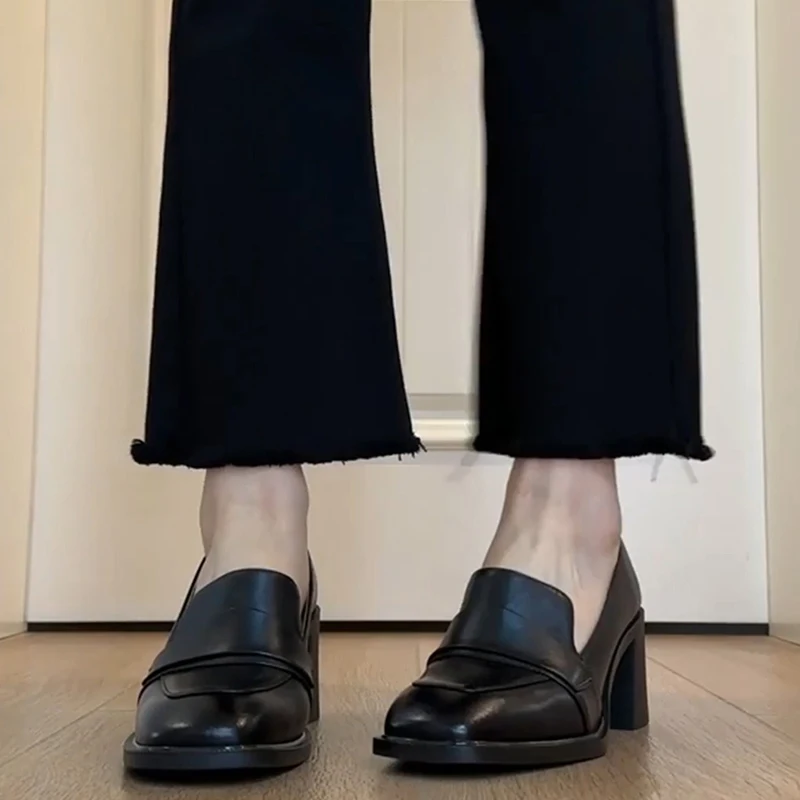
Creating Sophisticated Looks with Skirts and Dresses
Leather loafers bring unexpected sophistication to professional skirts and dresses, creating outfits that balance femininity with practical comfort:
Skirt Styles and Lengths
For workplace appropriateness, skirt hems typically fall at the knee or below when paired with loafers:
Pencil skirts: The structured nature of pencil skirts complements the classic lines of leather flat loafers. This pairing creates a timeless professional look, especially in coordinating colors like a navy skirt with navy or brown loafers.
A-line and pleated skirts: These feminine silhouettes gain professional grounding when paired with substantial loafers. The contrast between the flowing skirt and structured shoe creates visual interest while maintaining workplace appropriateness.
Midi skirts: Midi lengths work beautifully with loafers, creating an elegant proportion. Try a flowing midi skirt with penny loafers for a look that transitions easily from meetings to after-work events.
Professional Dresses
Loafers can transform the feel of workplace dresses:
Shirtdresses: The preppy, structured nature of shirtdresses makes them natural partners for classic penny or tassel loafers. This combination references traditional workwear while feeling thoroughly modern.
Wrap dresses: Soften the business impact of a wrap dress by pairing it with polished leather loafers instead of pumps. The combination balances feminine and practical elements.
Shift dresses: Simple shift dresses gain character and comfort when styled with distinctive loafers. Try horsebit loafers to add visual interest to a minimal dress.
Seasonal Considerations
In warmer months, bare legs can work with loafers in many workplace settings. For cooler weather or more conservative environments, sheer tights in coordinating colors maintain a polished appearance. Avoid athletic ankle socks or thick, casual hosiery, which undermine the refined nature of workplace loafer styling.
Layering with Blazers and Professional Separates
The addition of tailored top layers can elevate loafer-based outfits to new levels of workplace sophistication:
The Power of Blazers
A well-fitted blazer instantly increases the formality of any loafer outfit, making even casual styles office-appropriate. For maximum impact:
– Match your blazer to your pants or skirt for a suit-like effect
– Ensure your loafers are well-polished when wearing structured blazers
– Consider color harmony between your blazer buttons and loafer hardware
Creating Cohesive Color Stories
Build workplace outfits around complementary color schemes:
– Navy blazer + cream blouse + tan tassel loafers
– Black blazer + white shirt + black penny loafers
– Burgundy blazer + light blue shirt + dark brown horsebit loafers
Business Casual Knitwear
For less formal environments, fine-gauge cardigans and sweaters can replace blazers:
– Merino wool cardigan + silk shell + slim trousers + tassel loafers
– Lightweight sweater + button-down shirt + pencil skirt + penny loafers
– Turtleneck + wide-leg pants + heeled loafers
Accessory Coordination
Create visual cohesion by connecting your loafers to other accessories:
– Match your belt to your loafers for traditional business attire
– Coordinate hardware on bags with loafer details
– Echo leather textures between loafers and other leather goods
Building a capsule work wardrobe around quality leather loafers provides exceptional versatility, as these timeless shoes can anchor numerous professional looks while maintaining all-day comfort.
The Sock Question: Navigating Hosiery Options
The right hosiery choice can make or break a loafer-based workplace outfit:
The Bare Ankle Look
The no-sock look with loafers can work in many professional settings, particularly during warmer months and in more casual workplaces. To make this look office-appropriate:
– Ensure pants hit at the right length (slightly above or at the ankle)
– Keep loafers impeccably clean and polished
– Consider the office culture before showing bare ankles
No-Show Sock Solutions
For the sockless look with added comfort, no-show socks are invaluable:
– Opt for quality versions with silicone heel grips to prevent slipping
– Choose moisture-wicking materials for all-day freshness
– Select skin-toned options that truly disappear under your loafers
Visible Socks in Professional Settings
When visible socks are preferred or seasonally necessary:
– Fine-gauge trouser socks in colors that complement your outfit
– Subtle patterns (small dots, fine stripes) can add personality while maintaining professionalism
– Avoid athletic socks, thick casual socks, or novelty patterns in formal workplaces
Seasonal Transitions
Adapt your hosiery approach throughout the year:
– Summer: No-show socks or bare ankles where appropriate
– Fall/Spring: Lightweight trouser socks or sheer hosiery
– Winter: Warmer trouser socks, tights with skirts and dresses
The key is ensuring your hosiery choice maintains the clean, intentional look that makes loafers so effective in professional settings.
Seasonal Adaptation: Wearing Loafers Year-Round
One of the greatest advantages of leather loafers is their versatility across seasons:
Spring Styling
As temperatures warm, incorporate loafers into transitional outfits:
– Lighter neutral colors (tan, taupe, navy)
– Pair with cropped trousers without socks as weather permits
– Layer with lightweight blazers and cardigans
Summer Workplace Strategies
Keep cool while maintaining professionalism:
– Opt for unlined or perforated loafers for breathability
– Pair with lightweight fabrics like linen-blend trousers or cotton dresses
– No-show socks are essential for comfort and shoe preservation
– Consider lighter colors that reflect rather than absorb heat
Fall Transitions
Incorporate richer textures and colors:
– Suede loafers add seasonal texture
– Deeper colors like burgundy, forest green, and chocolate brown
– Layer with lightweight wool trousers and structured blazers
Winter Options
Contrary to popular belief, loafers can work well in winter with thoughtful styling:
– Pair with wool trouser socks for warmth
– Opt for loafers with sturdier soles for traction
– Protect leather from salt and slush with appropriate weather treatments
– Consider reserving loafers for indoor wear in extreme conditions
Seasonal versatility of leather loafers makes them a sound investment for year-round professional wear, allowing you to build outfits that transition seamlessly throughout the changing weather.
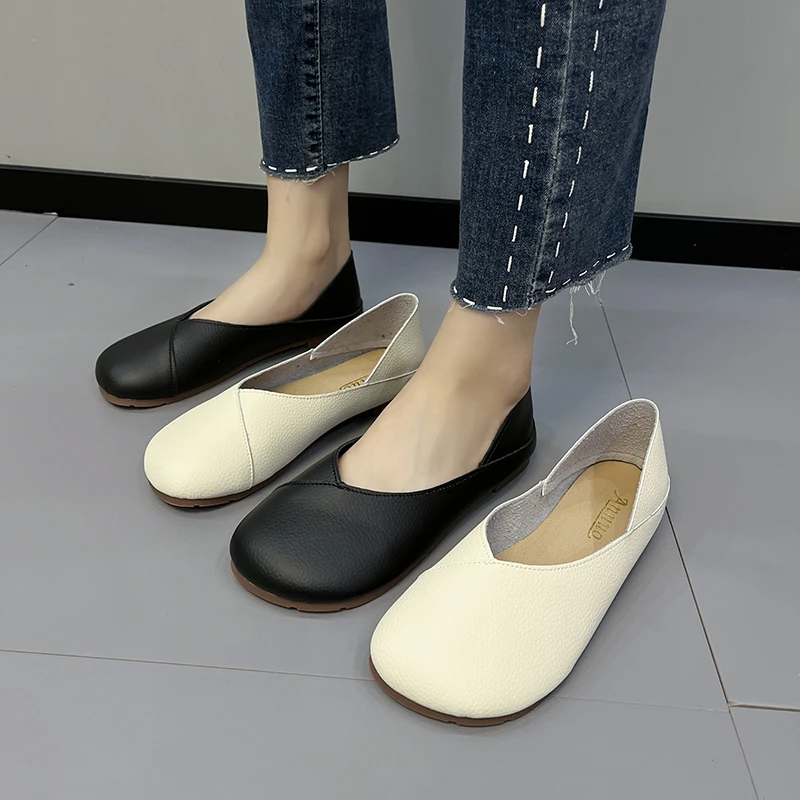
Professional Polish: Essential Styling Details
The difference between a good loafer outfit and a great one often comes down to thoughtful details:
Color Coordination Principles
Master these color approaches for professional loafer styling:
– Monochromatic: Match loafers to trousers for a lengthening effect
– Complementary: Create intentional contrast with colors that enhance each other
– Neutral foundation: Use black flat loafers as a versatile base for colorful outfits
Appropriate Heel Heights
Different contexts call for different heel elevations:
– Flat loafers (0-0.5”): Most versatile for daily wear across environments
– Low heel (0.5-1”): Adds subtle height while maintaining comfort
– Medium heel (1-2”): Increases formality for dressier workplace settings
– Higher heels (2”+): Best reserved for less active professional roles
Accessorizing with Intention
Create cohesive looks by connecting elements:
– Match metal hardware on loafers with jewelry tones
– Consider complementary leather goods (belts, bags, portfolios)
– Keep proportions balanced—chunky loafers pair well with more substantial accessories
Ensuring Proper Fit
The right fit is crucial for both comfort and appearance:
– Loafers should hug the foot without pinching
– Allow approximately 3/8” of space between your longest toe and the shoe end
– Width should accommodate your foot without slipping or binding
– Consider trying loafers later in the day when feet are naturally more swollen
Attention to these details elevates loafer styling from basic to sophisticated, ensuring your professional appearance is intentional and polished.
Mastering Comfort: Making Loafers Work All Day
Even the most stylish loafers won’t enhance your professional presence if they’re uncomfortable. Maximize workday comfort with these strategies:
Breaking In New Leather Loafers
Properly breaking in new loafers prevents discomfort during important workdays:
– Wear them around home with thick socks before debuting them at the office
– Use a quality leather conditioner to soften stiff areas
– Target problem spots with a wooden shoe stretcher if needed
– Consider professional stretching services for persistent trouble spots
Supportive Insole Options
Enhance built-in comfort with strategic additions:
– Cushioned insoles add shock absorption for hard office floors
– Three-quarter length options won’t crowd the toe box
– Heel cups provide stability and prevent slipping
– Arch support inserts help prevent fatigue during long days
Managing Common Issues
Address typical loafer comfort challenges:
– Heel slipping: Try heel grips or tongue pads to improve fit
– Rubbing at the instep: Apply moleskin to the underside of the tongue
– Toe box pressure: Look for styles with roomier toe boxes or have existing pairs stretched
Rotation Strategy
Extend both comfort and loafer lifespan:
– Alternate between at least two pairs of work shoes
– Allow 24-48 hours between wearings for shoes to fully dry and reshape
– Consider different styles for different workplace activities
Comfortable flat loafers with quality construction provide the foundation for day-long comfort, but these additional strategies ensure you’ll remain focused on your work rather than foot discomfort.
Women's Comfortable Flat Loafers, Women's Leopard Print Loafers, Women's Low Heel Loafers
$82.50 Select options This product has multiple variants. The options may be chosen on the product pageWomen's Block Heel Loafers, Women's Heeled Penny Loafers, Women's Monk Strap Loafers
$194.04 Select options This product has multiple variants. The options may be chosen on the product pageWomen's Comfortable Flat Loafers, Women's Leather Flat Loafers, Women's Round Toe Flat Loafers
$124.88 Select options This product has multiple variants. The options may be chosen on the product pageWomen's Black Flat Loafers, Women's Black Penny Loafers, Women's Classic Tassel Loafers
$194.28 Select options This product has multiple variants. The options may be chosen on the product pageWomen's Classic Tassel Loafers, Women's Suede Penny Loafers
Price range: $133.16 through $147.56 Select options This product has multiple variants. The options may be chosen on the product pageWomen's Classic Driving Loafers, Women's Classic Penny Loafers, Women's Comfortable Flat Loafers
$75.28 Select options This product has multiple variants. The options may be chosen on the product page
Do’s and Don’ts: Common Styling Mistakes to Avoid
| Do | Don’t |
|---|---|
| Invest in quality leather loafers that will maintain their shape and shine | Choose faux leather options that may crack or lose shape quickly |
| Polish and condition leather regularly to maintain professional appearance | Allow loafers to become scuffed, dull or visibly worn |
| Select loafer styles appropriate to your specific workplace culture | Wear overly casual driving loafers or boat shoes as substitutes in formal settings |
| Ensure proper fit with adequate toe room and secure heels | Tolerate pinching or slipping that affects your gait and comfort |
| Coordinate loafers thoughtfully with the rest of your outfit | Mix too many competing textures or colors in one ensemble |
| Pay attention to pant length and proportions | Allow pants to pool around ankles or expose too much leg |
| Consider the appropriate sock choice for your environment | Wear athletic or casual socks with professional loafers |
| Store loafers with shoe trees to maintain shape | Toss loafers in a closet where they may become misshapen |
Maintaining your leather loafers properly not only extends their lifespan but ensures they continue to enhance your professional appearance. Following the guidance in this ultimate guide to pristine leather loafers will help preserve your investment for years to come.
From 9-to-5 to Evening: Transitioning Loafers Beyond Work
One of the greatest advantages of leather loafers is their ability to transition seamlessly from workday to evening engagements:
Work-to-Dinner Transformations
Simple changes can adapt your office loafer outfit for after-hours events:
– Remove a blazer and add a statement necklace with a work dress and loafers
– Switch a structured work bag for a smaller clutch while maintaining your loafer-based outfit
– Add bolder makeup or accessories while keeping your comfortable loafer foundation
Client Dinner Sophistication
For work-related social functions, loafers can maintain professionalism while feeling appropriate for restaurant settings:
– Heeled loafers with a tailored dress offer comfort during extended networking events
– Polished penny loafers with slim trousers and a silk blouse transition beautifully to upscale dining
– Tassel loafers with business separates maintain authority during client meals
Weekend Adaptations
Professional loafers can also shift into weekend wear:
– Pair work loafers with dark denim and a casual blazer for smart-casual weekend events
– Style tassel loafers with chinos and a quality sweater for elevated weekend brunches
– Wear penny loafers with casual dresses for a preppy weekend look
The versatility of well-chosen leather loafers extends their value proposition beyond work hours, making them one of the most practical investments in your professional wardrobe.
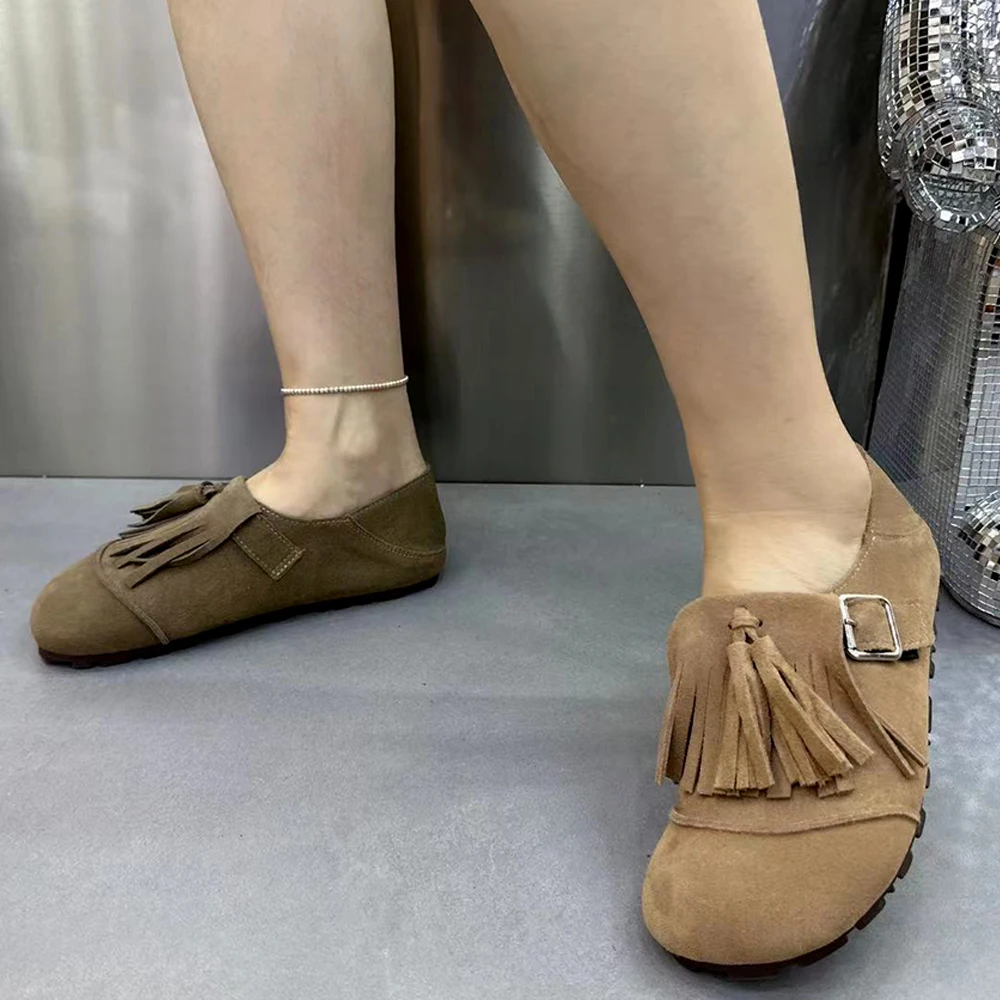
How to Care for Your Professional Loafers
Maintaining your leather loafers is essential for preserving their workplace-appropriate appearance:
Basic Cleaning Routine
- Wipe loafers with a soft cloth after each wearing to remove dust
- Clean with a damp cloth and mild soap for stubborn dirt, then wipe dry
- Apply leather cleaner appropriate for your loafer material (smooth leather, suede, patent)
- Allow shoes to fully dry at room temperature away from direct heat
Regular Maintenance
- Condition smooth leather every 5-10 wearings to prevent drying and cracking
- Apply polish in matching or neutral colors to maintain shine
- Protect with water-repellent spray, especially during inclement weather
- Treat suede with appropriate protectors and refresh with a suede brush
Proper Storage
- Insert cedar shoe trees to absorb moisture and maintain shape
- Store in dust bags or shoe boxes when not in regular rotation
- Keep pairs on shoe racks rather than piled in closets
- Avoid prolonged exposure to direct sunlight or extreme temperatures
Addressing Common Issues
- Treat scuffs immediately with matching polish or specialized products
- Manage water spots by allowing to dry completely, then conditioning
- Address squeaking with talcum powder under the insole
- Have worn heels or soles repaired promptly by a professional cobbler
With proper care, quality leather loafers can provide years of professional service. Learning how to style traditional leather loafers with appropriate maintenance will maximize both their lifespan and their contribution to your professional image.
Are Loafers Appropriate for All Professional Settings?
While loafers have gained widespread acceptance in professional environments, appropriateness varies by context:
Conservative Industries
In traditional legal, finance, and certain corporate environments, loafers require thoughtful application:
– Stick with classic penny or horsebit styles in polished black or dark brown
– Ensure impeccable condition and shine
– Consider reserving them for business casual days in ultra-conservative settings
– Pair with equally formal attire (suits, tailored separates)
Creative Fields
In marketing, design, media, and similar industries, loafers enjoy nearly universal acceptance:
– Experiment with colors, materials, and modern interpretations
– Express personal style through distinctive loafer choices
– Consider them appropriate for client meetings and presentations
– Use loafers as a foundation for creative professional expression
Client-Facing Considerations
When meeting external clients, consider their industry standards:
– Research client culture before selecting footwear
– Err on the more formal side for initial meetings
– Match your loafer choice to the meeting context and location
Gender-Specific Considerations
While loafers are increasingly gender-neutral, some workplace cultures maintain different expectations:
– In very traditional environments, women may find heeled loafers more readily accepted
– Men in highly formal sectors might reserve loafers for less ceremonial occasions
– Focus on quality and condition regardless of gender-specific styles
The key is knowing your specific workplace culture and client expectations, then selecting loafer styles that align appropriately.
How Do Loafers Compare to Other Professional Footwear Options?
Understanding loafers’ position in the spectrum of workplace footwear helps inform appropriate styling choices:
Loafers vs. Pumps/Heels
Compared to traditional women’s professional heels, loafers offer:
– Superior comfort for extended wear and walking
– Stable foundation for active workplace roles
– More versatile seasonal transition
– Generally more casual perception in very formal settings
Loafers vs. Oxfords/Derbies
Compared to laced formal shoes, loafers provide:
– Easier on/off convenience
– Slightly more casual positioning
– Greater styling versatility with casual and formal attire
– Often lighter weight for all-day comfort
Loafers vs. Flats
Compared to ballet flats or other women’s flat options, loafers deliver:
– More substantial structure and support
– Greater durability and longevity
– More professional appearance in most contexts
– Better weather adaptability
The primary advantage loafers hold over most professional footwear alternatives is their unique balance of comfort, durability, and style versatility. While other options might excel in specific categories (formality of oxfords, femininity of heels), loafers provide the most comprehensive solution for diverse workplace needs.
Conclusion: Stepping Confidently into the Workplace
Leather loafers represent that rare combination of style, comfort, and versatility that makes them invaluable in professional settings. Their ability to adapt across dress codes, seasons, and outfit combinations establishes them as foundational pieces in any work wardrobe. By understanding the nuances of loafer styles and mastering strategic styling principles, you can leverage these versatile shoes to enhance your professional presence.
Remember that confidence comes not just from wearing appropriate footwear, but from wearing it well. Invest in quality leather loafers that offer both comfort and sophistication. Maintain them properly to ensure they continue projecting professionalism. And most importantly, find the specific styles and combinations that align with both your workplace culture and personal aesthetic.
With the guidance provided in this article, you’re well-equipped to navigate professional environments with both style and comfort, allowing your focus to remain on your work rather than your feet. When chosen thoughtfully and styled appropriately, leather loafers become more than just shoes—they become reliable partners in your professional journey.

